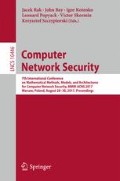Abstract
We present a new system that offers detection and analysis of modern complex malware including user-oriented and targeted attacks. These attacks stem from users’ misbehavior, e.g. misinterpreting or ignoring security alerts, which lead to proliferation of malicious objects inside trusted perimeter of cyber-security systems (e.g. exclusion list of AVs). The attack mechanisms include strategic web compromise, spear phishing, insider threat and social network malware. Moreover, targeted attacks often deliver zero-day malware that is made difficult to be detected, e.g. due to distributed malicious payload.
The system provides a secure container enabling user-dependent environment in malicious activity analysis, which is achieved by user interaction simulation in real time. The user interaction simulator recognizes GUI components and clicks through them according to click patterns of a typical user, e.g. office employee. To provide effective malware detection, our team developed a new technology for deep dynamic inspection of system-wide behavior, which is based on structural analysis of so-called activity trees defined in the domain of system functionalities. We use Modified Hierarchical Colored Petri Nets for run-time recognition of system functionalities including obfuscated and distributed ones. We our system with corpus of real malware families. Results show high efficiency of our system in detecting and blocking malware while having low system overhead.
Access this chapter
Tax calculation will be finalised at checkout
Purchases are for personal use only
References
Cohen, F.: Computer viruses theory and experiments, Computers and Security, v. 6 (1987)
Malware Statistics Report by AV-Test Institute. https://www.av-test.org/en/statistics/malware/
Tokhtabayev, A.G., Skormin, V.A., Dolgikh, A.M.: Expressive, efficient and obfuscation resilient behavior based IDS. In: Gritzalis, D., Preneel, B., Theoharidou, M. (eds.) ESORICS 2010. LNCS, vol. 6345, pp. 698–715. Springer, Heidelberg (2010). doi:10.1007/978-3-642-15497-3_42
Tokhtabayev, A., Skormin, V., Dolgikh, A.: Detection of worm propagation engines in the system call domain using colored petri nets. In: Proceedings of the IEEE IPCCC ’07, USA, December 2008
Jensen, K.: Coloured Petri nets (2nd ed.): basic concepts, analysis methods and practical use, vol. 1. Springer, Berlin (1996)
Bernaschi, M., Grabrielli, E., Mancini, L.: Operating system enhancements to prevent the misuse of system calls. In: Proceedings of the ACM CCS 2000, pp. 174–183 (2000)
Kang, D., Fuller, D., Honavar, V.: Learning classifiers for misuse and anomaly detection using a bag of system calls representation. In: Proceedings of the 6th IEEE Systems Man and Cybernetics Information Assurance Workshop (IAW), pp. 118–125 (2005)
Skormin, V., Volynkin, A., et al.: Run-Time detection of malicious self-replication in binary executables. J. Comput. Secur. 15(2), pp. 273–301 (2007)
Bayer, U., et al.: Dynamic analysis of malicious code. J. Comput. Virol. 2(1), 67–77 (2006)
Christodorescu, M., Jha, S., Kruegel, C.: Mining specifications of malicious behavior. In: Proceedings of the ESEC-FSE’07, NY, USA (2007)
Kouznetsov, V.: US Patent 6973577 B1: System and Method for Dynamically Detecting Computer Viruses Through Associative Behavioral Analysis of Runtime State, 6 December 2005
Martignoni, L., et al.: A layered architecture for detecting malicious behaviors. In: Proceedings of the RAID 2008 (2008)
Author information
Authors and Affiliations
Corresponding author
Editor information
Editors and Affiliations
Rights and permissions
Copyright information
© 2017 Springer International Publishing AG
About this paper
Cite this paper
Tokhtabayev, A., Kopeikin, A., Tashatov, N., Satybaldina, D. (2017). Malware Analysis and Detection via Activity Trees in User-Dependent Environment. In: Rak, J., Bay, J., Kotenko, I., Popyack, L., Skormin, V., Szczypiorski, K. (eds) Computer Network Security. MMM-ACNS 2017. Lecture Notes in Computer Science(), vol 10446. Springer, Cham. https://doi.org/10.1007/978-3-319-65127-9_17
Download citation
DOI: https://doi.org/10.1007/978-3-319-65127-9_17
Published:
Publisher Name: Springer, Cham
Print ISBN: 978-3-319-65126-2
Online ISBN: 978-3-319-65127-9
eBook Packages: Computer ScienceComputer Science (R0)

